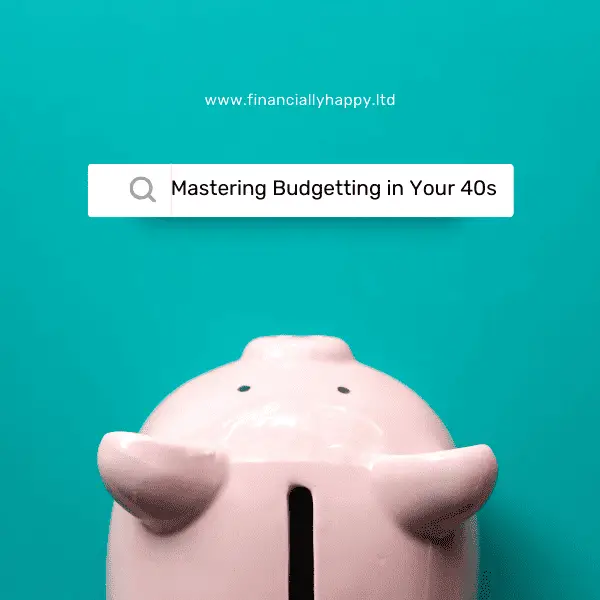Building Wealth in Your 30s to Enjoy in Your 40s: A Comprehensive Guide
Welcome to the Building Wealth in Your 30s to Enjoy in Your 40s: A Comprehensive Guide. This guide will help you navigate the financial landscape of your 30s and prepare for a prosperous future in your 40s. 💰🚀
Building wealth in your 30s for a financially secure future in your 40s involves setting clear financial goals, creating a budget, eliminating high-interest debt, and making smart investment choices.

Setting Financial Goals
Setting clear and achievable financial goals is the cornerstone of building wealth. It’s like setting the GPS for your financial journey. Without a clear destination, you’ll be driving around aimlessly. So, let’s dive into how you can set your financial goals effectively:
Define your goals: The first step is to define what you want to achieve financially by your 40s. Do you want to own a house? Do you want to have a certain amount in your retirement account? Or maybe you want to start a business? Be as specific as possible. The more specific your goals, the easier it will be to plan for them. For example, instead of saying “I want to save money,” say “I want to save $50,000 for a down payment on a house.” 🎯
Set a timeline: Once you’ve defined your goals, set a timeline for achieving them. This will give you a clear timeframe to work towards and will help you stay on track. For example, if your goal is to save $50,000 for a down payment on a house in 5 years, that gives you a clear target to aim for. ⏰
Break down your goals: Large financial goals can seem daunting. But remember, every journey starts with a single step. Break down your large goals into smaller, manageable steps. For example, if your goal is to save $50,000 in 5 years, break it down to saving $10,000 a year, or about $833 a month. This makes your goal seem more achievable and less overwhelming. 📈
Review and adjust your goals: Life is unpredictable, and your financial situation can change. Reviewing your financial goals regularly and adjusting them as needed is important. Maybe you get a raise at work and can save more each month, or maybe you have an unexpected expense and need to save less. That’s okay. The important thing is to keep your goals in sight and adjust your plan as needed. 🔄
Building wealth is a marathon, not a sprint. It’s about making consistent progress towards your financial goals. So, set your goals, make your plan, and start your journey to financial freedom. 💰🚀
Creating and Sticking to a Budget
Creating and sticking to a budget is like having a financial roadmap. It helps you see where your money is coming from, where it’s going, and most importantly, it helps you make plans for the future. Here’s a more detailed look at how to create and stick to a budget:
Track your income and expenses: The first step in creating a budget is understanding your financial situation. Start by tracking your income and expenses for a month or two. Write down all your sources of income, including your salary, any side hustles, and passive income sources. Next, track your expenses. This includes everything from your rent or mortgage, utilities, groceries, and entertainment. The goal here is to get a clear picture of your financial situation. Where is your money coming from and where is it going? 💼💸
Prioritize your spending: Once you have a clear picture of your income and expenses, it’s time to prioritize your spending. Start by allocating funds to your needs first. This includes things like rent or mortgage, utilities, groceries, and healthcare. Once your needs are covered, you can allocate money towards your wants. This includes things like entertainment, eating out, and hobbies. Remember, spending money on things you enjoy is okay, but only after your needs are covered. 🍽️🎮
Create a savings category: After you’ve allocated money for your needs and wants, it’s time to create a savings category. This is where you’ll allocate money for your financial goals, like saving for a house, retirement, or an emergency fund. The earlier you start saving, the better. 🏦
Adjust your budget as needed: Your financial situation will change over time, and so should your budget. Maybe you get a raise at work, or maybe your expenses increase. That’s okay. The important thing is to adjust your budget as needed. Review your budget regularly and make adjustments as needed. This will ensure that your budget continues to serve its purpose – to help you manage your money effectively. 🔄
A budget is not meant to restrict you, but to empower you. It’s a tool allowing you to control your money and make informed decisions about your financial future. 💰🚀
Building an Emergency Fund
An emergency fund is your financial safety net. It’s there to catch you when life throws you a curveball, like a sudden job loss, a car repair, or a medical emergency. Here’s a more detailed guide on how to build your emergency fund:
Start small: Building an emergency fund can seem daunting, especially if you’re starting from scratch. But remember, even a small emergency fund can make a big difference. Start with what you can. Even saving a small amount like $500 can cover many minor emergencies and give you peace of mind. Every little bit helps, and these small amounts will increase over time. 🌱
Set a goal: While a small emergency fund is a good start, your ultimate goal should be saving three to six months’ living expenses. This can cover larger emergencies, like a job loss or a major medical expense. Having this buffer can give you the time and flexibility you need to navigate these situations without going into debt. 🎯
Make regular contributions: Consistency is key when building an emergency fund. Set up automatic transfers to your emergency fund each time you get paid. This “pay yourself first” approach ensures you consistently build your emergency fund over time. 💰
An emergency fund is not a luxury, but a necessity. It’s your first line of defense against financial emergencies. So start building your emergency fund today, and give yourself the gift of financial security. 🎁🚀
Eliminating High-Interest Debt
High-interest debt, like credit card debt or payday loans, can be a major roadblock on your journey to building wealth. It’s like trying to fill a bucket with a hole in it. No matter how much you put in, you’ll never fill the bucket if you don’t plug the hole. Here’s how to tackle high-interest debt:
Prioritize high-interest debt: Not all debt is created equal. High-interest debt costs you more over time and can keep you in a cycle of debt. That’s why it’s important to prioritize paying off high-interest debt first. This is often called the “avalanche method” of debt repayment. You first pay off the debt with the highest interest rate, while making minimum payments on your other debts. Once the highest-interest debt is paid off, you move on to the debt with the next highest interest rate, and so on. 📈
Make more than the minimum payment: If possible, try to pay more than the minimum amount due each month. Minimum payments can keep you in debt longer, resulting in more interest charges. Any extra money you can put towards your debt will help you pay it off faster. 💸
Consider debt consolidation: Debt consolidation might be an option if you have multiple high-interest debts. This involves taking out a new loan to pay off your existing debts. The goal is to secure a lower interest rate, saving you money over time and simplifying your payments. However, it’s important to understand the consolidation loan’s terms and continue practicing good financial habits to avoid ending up in more debt. 🔄
Eliminating high-interest debt is a crucial step towards building wealth. It frees up more of your money to be put towards your financial goals. So start tackling your high-interest debt today, and take one step closer to financial freedom. 🚀💰
Increasing Retirement Savings
Increasing your retirement savings in your 30s is like planting seeds for a bountiful harvest in your 40s and beyond. The more you save now, the more time your money has to grow, thanks to the power of compound interest. Here’s how to ramp up your retirement savings:
Maximize your 401(k) or pension contributions: If your employer offers a 401(k) match in the US or contributes to your pension scheme in the UK, make sure you’re contributing enough to get the full match. This is essentially free money that can supercharge your retirement savings. For example, if your employer matches 50% of your contributions up to 6% of your salary, and you’re not contributing at least 6%, you’re leaving money on the table. So, aim to contribute at least enough to get the full match. 💰
Open an IRA or a Personal Pension: In the US, an Individual Retirement Account (IRA) can provide additional opportunities to save for retirement. In the UK, consider opening a Personal Pension. Both can be a valuable part of your retirement savings strategy. 🏦
Consider a Roth or tax-free account: In the US, Roth 401(k)s and Roth IRAs offer tax-free withdrawals in retirement. In the UK, consider ISAs, which offer tax-free savings and investments. These can be great options if you expect to be in a higher tax bracket in retirement or want to take advantage of tax-free growth. 🚀
Starting early and contributing consistently is the key to increasing your retirement savings. Even small increases in your contributions can make a big difference over time. So start planting your retirement savings seeds today, and prepare to reap the rewards in your 40s and beyond. 🌱💰
Making Smart Investment Choices
Making smart investment choices is like being the captain of your own financial ship. You decide where to set sail and how to navigate the waters of the financial market. Here are some tips to help you chart a course towards wealth:
Diversify your portfolio: Just as a ship’s captain wouldn’t rely on a single route, you shouldn’t put all your financial eggs in one basket. Diversification is a key strategy for managing risk and ensuring your portfolio can weather any financial storm. This means spreading your investments across different asset classes, such as stocks, bonds, and real estate. It’s all about balance. 🌐
Invest for the long term: Resist the temptation to chase the financial equivalent of buried treasure. Short-term gains can be exciting, but true wealth is built over time. Focus on investments that have the potential to grow steadily over the long term. Remember, investing is a marathon, not a sprint. 📈
Consider your risk tolerance: Just as every sea captain must consider the safety of their crew, you must consider your own comfort with risk. Make sure your investment strategy aligns with your risk tolerance. This means balancing higher-risk investments with those that are more stable. 🛡️
By making smart investment choices, you can set a course towards building wealth in your 30s and enjoying it in your 40s and beyond. So hoist the sails and set off on your financial journey! 🚀💰
Taking advantages of your employers benefits
Taking advantage of your employer’s benefit offerings is like finding hidden treasure in your own backyard. These benefits can significantly boost your wealth-building efforts. Here’s how:
Maximise your pension contributions: If your employer offers a pension match, it’s like they’re giving you free money. Make sure you’re contributing enough to get the full match. This can significantly boost your retirement savings.
For example, if your employer matches 50% of your contributions up to 6% of your salary, and you’re not contributing at least 6%, you’re leaving money on the table. So, aim to contribute at least enough to get the full match. 💰
Use your Health Savings Account (HSA) or Flexible Spending Account (FSA): These accounts allow you to set aside pre-tax pounds for healthcare expenses. This can result in significant savings, especially if you have regular healthcare costs. Plus, HSA funds can be invested and grow tax-free, providing another avenue for wealth building. 🏥
Take advantage of employee share schemes: If your employer offers a share scheme, you can buy company stock at a discount. This can be a great way to invest in your company and potentially realise significant gains if the stock price increases. 📈
Remember, your employer’s benefit offerings are a valuable part of your compensation package. Make sure you’re taking full advantage of them to boost your wealth-building efforts. 🚀💰

Preparing for Homeownership
Homeownership can be a significant wealth-building tool but also a major financial commitment. Here’s how to prepare for this important step:
- Save for a down payment: This is often the biggest hurdle to homeownership. Aim to save at least 20% of the home’s purchase price for a down payment. This can help you avoid the need for private mortgage insurance (PMI) and can lower your monthly mortgage payments. Remember, the larger your down payment, the smaller your loan will be. 🏠
- Improve your credit score: Your credit score is crucial in securing a mortgage. A higher credit score can help you secure a lower mortgage rate, which can save you thousands of dollars over the life of your loan. Pay your bills on time, keep your credit card balances low, and avoid taking on new debt to help boost your score. 💳
- Consider your lifestyle: Homeownership is a long-term commitment. Make sure it aligns with your lifestyle and financial goals. Consider factors like your job stability, willingness to take on home maintenance responsibilities, and long-term life plans. 🌐
Homeownership is a significant step towards building wealth, but ensuring you’re financially ready is important. So start preparing today for the keys to your future home! 🚀🔑💰
FAQs Section: Building Wealth in Your 30s to Enjoy in Your 40s
How to invest in your 30s to be wealthy in your 40s?
Start by setting clear financial goals, creating a budget, and eliminating high-interest debt. Then, focus on making smart investment choices, such as diversifying your portfolio through low cost index funds and investing for the long term.
How to build wealth from nothing in your 40s?
To build wealth from nothing in your 40s, start by setting clear financial goals. Create a budget to manage your income and expenses, and focus on eliminating high-interest debts. Save and invest consistently, diversify your income streams, and take advantage of any employer’s benefit offerings. It’s never too late to start your wealth-building journey.
What is considered wealthy at 40 years old?
Wealth is subjective and can vary greatly depending on factors like location, lifestyle, and personal financial goals. However, a good benchmark is having a net worth that is two to three times your annual income.
Can you build wealth in your 40s?
Absolutely! Building wealth in your 40s is entirely possible. It involves setting clear financial goals, managing your budget effectively, eliminating debts, saving consistently, making smart investment choices, and diversifying your income streams. It’s never too late to start your wealth-building journey.
How can I build my wealth in my 30s?
Building wealth in your 30s involves setting clear financial goals, creating a budget, eliminating high-interest debt, and making smart investment choices. It also involves building an emergency fund and creating multiple streams of income.
What is the first ingredient to building wealth?
The first ingredient to building wealth is having a clear financial plan. This includes setting financial goals, creating a budget, and having a plan to eliminate debt.
What assets to buy in your 30s?
In your 30s, consider investing in low cost globally diversified index funds weighted towards stocks and also think about real estate. Contribute to retirement accounts like especially worked based ones that offer a match. Diversification is key to balance risk and reward. Always align your investments with your financial goals and risk tolerance.
Conclusion: Building Wealth in Your 30s to Enjoy in Your 40s
Building wealth in your 30s to enjoy in your 40s is indeed a journey, not a destination. It’s about making smart financial decisions today that will pay off in the future. By setting clear financial goals, creating and sticking to a budget, eliminating high-interest debt, building an emergency fund, and making smart investment choices, you’re not just building wealth, you’re building a secure and enjoyable future. 🚀
Remember, every step you take, no matter how small, brings you closer to your financial goals. So keep going, keep growing, and before you know it, you’ll be reaping the rewards of your hard work in your 40s and beyond. 🌱💰
Ready to take the next step towards your financially happy future? Consider financial coaching to help you navigate your wealth-building journey. A financial coach can provide personalized advice and strategies to help you reach your goals faster. So why wait? Start your journey towards a financially secure future today! 💼🌟
If you’ve made it this far, congratulations! You’re already taking steps towards a healthier financial future. But maybe you’re feeling a bit overwhelmed. Maybe the of budgeting, saving, and investing still makes you break out in a cold sweat. Don’t worry, you’re not alone, and help is available.
At Financially Happy Money Coaching, I understand money isn’t just about numbers. It’s about emotions, behaviours, and life choices. That’s why we’re here to help you take the stress out of money and build wealth that aligns with your values and lifestyle.
Whether you’re just starting out on your financial journey or you’re looking to take your finances to the next level, we’re here to guide you every step of the way. I’ll help you understand your financial behaviours, set realistic goals, and create a personalized plan to achieve those goals.
So, why wait? Start your journey towards financial happiness today. Remember, the best time to start was yesterday. The second best time is now.
Click here to schedule your consultation and let’s make your money work for you, not vice versa. 💪💰
Remember, financial freedom isn’t a destination; it’s a journey. And every journey is easier when you have a guide. So, let’s embark on this journey together and create a financially happy future. 🚀💸
📚 Financial Freedom Resources
- The Ultimate Guide To Building Your Savings to $100,000! 📘 is a transformative book that equips readers with principles, strategies, and the mindset 🧠 needed to reach a $100,000 savings goal 💰. It’s a journey towards financial freedom 🚀, challenging beliefs 🤔, embracing new habits 🔄, and overcoming obstacles 💪.
- How to Manage Your Finances: Your Guide to Financial Freedom 📘 is a comprehensive resource packed with practical advice on budgeting 💰, investing 📈, reducing debt 💳, and building wealth 💎. It’s an essential guide for anyone, novice or experienced, aiming to take control of their financial future and achieve financial independence 🚀.
Remember, self-study is a powerful tool for life and financial transformation. Happy reading! 🎉
📚 Financial Freedom Resources
- The Ultimate Guide To Building Your Savings to $100,000! 📘 is a transformative book that equips readers with principles, strategies, and the mindset 🧠 needed to reach a $100,000 savings goal 💰. It’s a journey towards financial freedom 🚀, challenging beliefs 🤔, embracing new habits 🔄, and overcoming obstacles 💪.
- How to Manage Your Finances: Your Guide to Financial Freedom 📘 is a comprehensive resource packed with practical advice on budgeting 💰, investing 📈, reducing debt 💳, and building wealth 💎. It’s an essential guide for anyone, novice or experienced, aiming to take control of their financial future and achieve financial independence 🚀.
- Mastering Budgeting in Your 40s: Your Guide to Financial Freedom 📘 is your essential roadmap to financial savvy. Packed with tips on budgeting 💰, investing 📈, and debt management 💳, it’s the perfect toolkit for anyone in their 40s looking to secure their financial future and sail towards independence 🚀.
Remember, self-study is a powerful tool for life and financial transformation. Happy reading! 🎉









